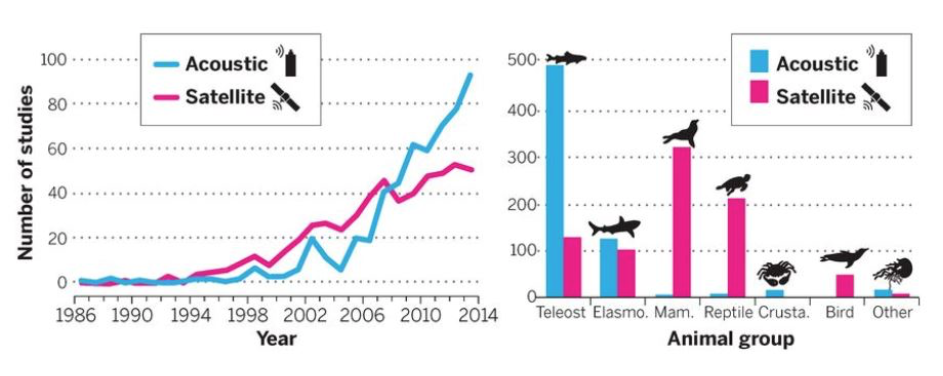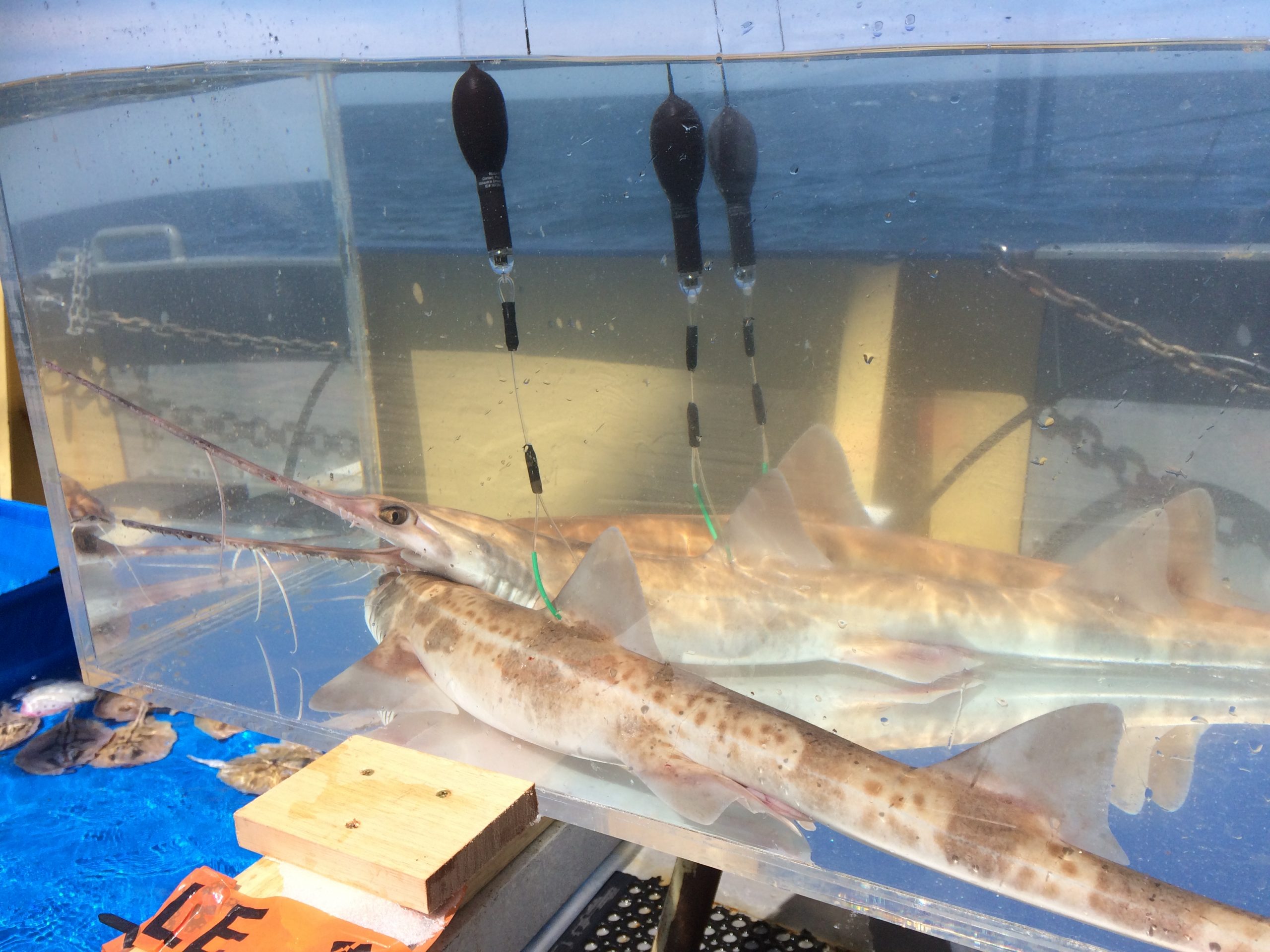Why movement matters
There has been a steady increase in the number of studies looking into the movement ecology of various species in marine ecosystems. While movement can be studied or inferred in multiple ways, the most prominent techniques involve telemetry, either acoustic or satellite. Innovations, miniaturizations and reductions in the cost of tags have led to the applicability to a variety of taxa from fish to mammals. While the innovations are impressive, it is the scientific insights that have evolved out of that which are truly impressive. So, to that question, why does movement matter?

Graphics illustrating the increase in telemetry studies over time and across groups. Figure from (Hussey et al., 2015).
Almost all organisms will move at some stage of their life, either under their own power or via physical processes (i.e. currents). Understanding these movements can be quite complex. For example, why do white sharks roam ocean basins only to return to certain areas (Bonfil et al., 2005)? Why do lobsters go on ‘great marches’ (Bertelsen and Hornbeck, 2009)? Such movements are often driven by particular needs such as feeding, reproduction or physiological tolerances. Furthermore, temporal patterns often play roles in these processes (i.e. seasonal migrations).

Common sawsharks about to be released with pop-up satellite archival tags (PSATs). Photo © Patrick Burke
Movement of animals influences a range of biologically significant factors that impact various ecosystem-level processes. These include predator-prey dynamics, habitat selection, population resilience, biological production and transport of energy. For example, tiger sharks can impact the movement and habitat use of sea turtles around Shark Bay, Australia (Heithaus et al., 2007). Avoidance of certain areas is considered related to the condition of the turtle whereas turtles in poor conditions selected for high-quality habitats but were subsequently at a higher risk for predation from tiger sharks (Heithaus et al., 2007).

Common sawsharks about to be released with pop-up satellite archival tags (PSATs). Photo © Patrick Burke
Movement data are increasingly incorporated in conservation management and policy. These forms of ocean management are often considered in two different contexts, static and dynamic (Lewison et al., 2015). Static ocean management is most commonly implemented with approaches such as Marine Protected Areas (MPAs) or time-area closures. These approaches have helped support critical habitat such as coral reefs. Dynamic ocean management is a promising new avenue to managing ocean resources, particularly for highly mobile organisms. What separates dynamic and static management is the incorporation of real-time or near real-time data on fluctuating biological, oceanographic, social or economic characteristics of the ocean (Lewison et al., 2015). For example, the Eastern Australian longline fishery adopted a dynamic ocean management approach to minimize incidental capture of southern bluefin tuna (SBT) (Thunnus maccoyii) (Hobday et al., 2011). Habitat preferences of SBT derived from historical pop-up satellite archival tag (PSAT) data paired with near real-time ocean temperatures are modelled into a ‘nowcast’, depicting current conditions. This modelling results in fishing areas delineated into three realistic zones of the increasing likelihood of encountering SBT that is updated fortnightly during peak migration times to help avoid bycatch.
While the examples here are by no means exhaustive or all-inclusive, they provide insights into why researchers spend time and money deciphering animal movements. Understanding how an animal uses a particular environment or resource can help us conserve and manage that species and predict how they are likely to respond in the face of change.
References
Bertelsen, R.D., Hornbeck, J., 2009. Using acoustic tagging to determine adult spiny lobster (Panulirus argus) movement patterns in the Western Sambo ecological reserve (Florida, United States). New Zeal. J. Mar. Freshw. Res. 43, 35–46. https://doi.org/10.1080/00288330909509980
Bonfil, R., Meÿer, M., Scholl, M.C., Johnson, R., O’Brien, S., Oosthuizen, H., Swanson, S., Kotze, D., Paterson, M., 2005. Transoceanic migration, spatial dynamics, and population linkages of white sharks. Science (80-. ). 310, 100–103. https://doi.org/10.1126/science.1114898
Heithaus, M.R., Frid, A., Wirsing, A.J., Dill, L.M., Fourqurean, J.W., Burkholder, D., Thomson, J., Bejder, L., 2007. State-dependent risk-taking by green sea turtles mediates top-down effects of tiger shark intimidation in a marine ecosystem. J. Anim. Ecol. 837–844. https://doi.org/10.1111/j.1365-2656.2007.01260.x
Hobday, A.J., Hartog, J.R., Spillman, C.M., Alves, O., 2011. Seasonal forecasting of tuna habitat for dynamic spatial management. Can. J. Fish. Aquat. Sci. 68, 898–911. https://doi.org/10.1139/f2011-031
Hussey, N.E., Kessel, S.T., Aarestrup, K., Cooke, S.J., Cowley, P.D., Fisk, A.T., Harcourt, R.G., Holland, K.N., Iverson, S.J., Kocik, J.F., Flemming, J.E.M., Whoriskey, F.G., 2015. Aquatic animal telemetry: A panoramic window into the underwater world. Science (80-. ). 348, 1255642. https://doi.org/10.1126/science.1255642
Lewison, R., Hobday, A.J., Maxwell, S., Hazen, E., Hartog, J.R., Dunn, D.C., Briscoe, D., Fossette, S., O’Keefe, C.E., Barnes, M., Abecassis, M., Bograd, S., Bethoney, N.D., Bailey, H., Wiley, D., Andrews, S., Hazen, L., Crowder, L.B., 2015. Dynamic ocean management: Identifying the critical ingredients of dynamic approaches to ocean resource management. Bioscience 65, 486–498. https://doi.org/10.1093/biosci/biv018
